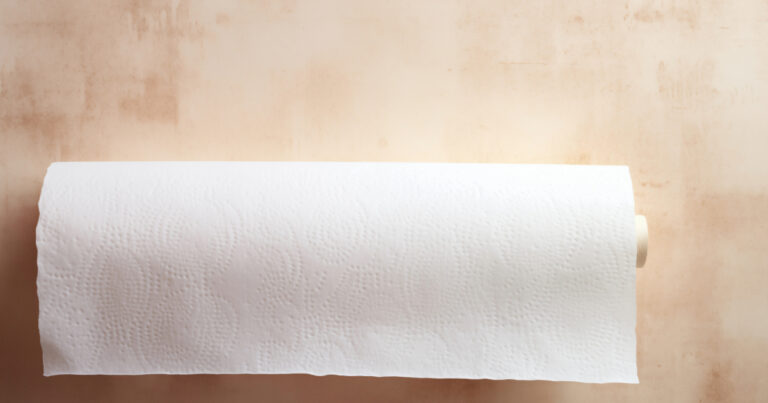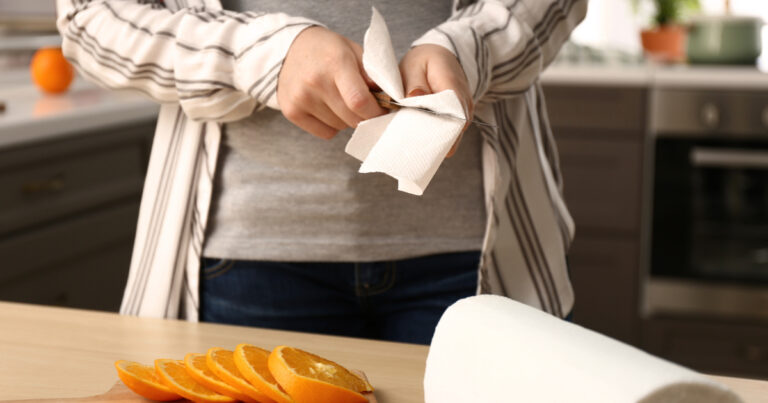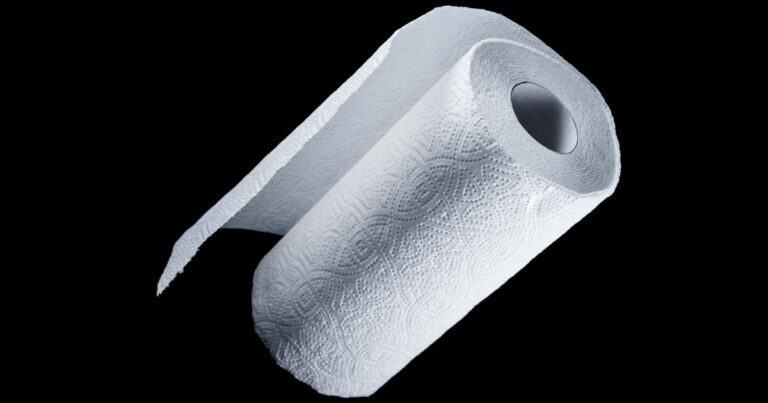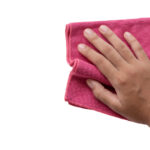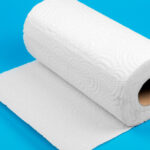Paper towels are a household staple used for cleaning, drying, and absorbing messes.

But what exactly are paper towels and how are they made?
What Are Paper Towels?
Paper towels are disposable, absorbent sheets made from paper pulp. They come in perforated rolls or stacks for use in home, commercial, and public settings. Paper towels soak up spills, dry surfaces, clean hands and tools, and more. Their absorbency comes from loosely woven fibers that wick moisture into the towel.
Unlike fabric towels, paper towels are designed for single use and then disposal. They provide a hygienic way to clean and dry while minimizing cross-contamination. Paper towels are essential for quick cleanup, especially for food preparation and public restrooms. Their convenience makes them a versatile staple in many households and businesses.
A Brief History of Paper Towels
The origin of paper towels traces back to the late 1800s and early 1900s:
- In 1907, the Scott Paper Company introduced paper tissues for hygienic use in restrooms. This helped prevent spreading germs via shared cloth towels.
- In 1917, the Brown Company in Berlin, New Hampshire began developing a paper towel product.
- By 1922, they had perfected the technique and mass production began under the brand name Nibroc (Corbin spelled backwards).
- In 1931, Scott Paper introduced their paper towel rolls for household kitchens.
- Since then, major manufacturers like Georgia-Pacific and Kimberly-Clark have come to dominate the market.
Paper towels surged in popularity throughout the 20th century for their convenience and sanitation compared to cloth. High production capabilities brought costs down, making paper towels affordable for households and businesses.
How Are Paper Towels Made?
Modern paper towel production involves a highly automated, efficient process. Here are the key steps:
- Paper pulp is created from virgin wood fibers or recycled materials like old paper products.
- The pulp mixture flows onto conveyor belts forming wide sheets.
- Rollers press and flatten the sheets to squeeze out water and bond the fibers.
- The sheets pass through heated dryers to remove any remaining moisture.
- Embossing rollers imprint texture which increases absorbency.
- Perforation machines add lines of perforations so towels can detach easily.
- Cutting blades slice the sheets into individual towels or rolls.
- Finally, paper towels are packaged and distributed for retail or commercial use.
Absorbency is enhanced by using coarser, irregular pulp fibers and creping the paper with embossed textures. Added pigments provide color, brightness, and designs.
Paper Towel Composition
Paper towels consist of a few basic components:
- Wood pulp fibers form the absorbent base material, either from virgin pulp or recycled content.
- Cotton fibers are sometimes added for extra strength and softness.
- Chemical additives give wet strength, softness, and absorbency. Common chemicals used include wet strength resins, polyvinyl alcohol, and polysaccharides.
- Dyes add color and aesthetic design elements.
- Fragrances give towels a fresh, pleasant scent.
The exact composition varies by brand and product type. In general, paper towels contain 50-80% hardwood pulp, 20-50% softwood pulp, and 0-10% cotton fibers. Virgin pulp versus recycled content ratios also differ. Additives make up 5% or less.
Paper Towel Sizes
Paper towels come in various sizes tailored to different uses:
- Half-fold towels (11 x 9 inches) are large enough for hands, but also used for counters and spills.
- Quarter-fold towels (11 x 5.5 inches) are compact for bathroom use.
- Slim-fold towels (11 x 7 inches) are a versatile in-between size.
- Shop towels (12.5 x 17 inches) are extra absorbent for auto shops and garages.
- Industrial wipes (9 x 12 inches) handle tough cleaning jobs.
- Roll towels (11 x 5.5 inches) offer pull-down convenience, typically in public restrooms.
Thickness ranges from 1-3 ply (layers). More plies means greater strength and absorbency.
Paper Towel Use Cases
Paper towels have many household, commercial, and industrial applications:
- Cleaning kitchen counters and tables
- Wiping up food and drink spills
- Absorbing grease while cooking
- Drying hands, dishes, and silverware
- Polishing mirrors, windows, and other surfaces
- Dusting furniture and electronics
- Wiping down bathroom sinks and mirrors
- Absorbing liquid from floors
- Cleaning hands and tools at garages, shops, and factories
- Wiping down gym equipment
- Arts and crafts projects
Their absorbent and disposable nature makes paper towels highly versatile for quick cleaning jobs. They provide sanitary, efficient cleanup across many contexts.
Paper Towel Consumption Statistics
Paper towels are used in massive quantities globally each year:
- Over 15 billion pounds of paper towels are produced annually worldwide.
- The average American household uses around 110 rolls per year.
- Commercial use accounts for 33% of paper towel consumption.
- The U.S. consumes the most per capita, at about 53 pounds per person yearly.
- Other high use regions include Canada, Western Europe, Japan, and Australia.
- Rising incomes and living standards increase paper towel usage as economies develop.
Paper towels represent a multibillion dollar market, indicative of their widespread daily use and demand.
Environmental Considerations
The sheer volume of paper towels used worldwide raises environmental concerns:
- High production requires significant water and energy resources.
- Most paper towels are bleached during manufacturing.
- Since they’re designed for single use, paper towels generate abundant waste.
However, manufacturers have made improvements:
- Recycled paper comprises 30-50% of many brands.
- Alternative fibers like bamboo are renewable and sustainable.
- Bleach-free towels reduce use of harsh chemicals.
- Slimmer dispensers, half-sheets, and improved efficiency decrease waste.
Consumers can also adopt habits to mitigate the impact:
- Use only what you need and avoid excess.
- Reuse towels for multiple tasks when practical.
- Recycle used paper towels whenever possible.
- Switch to more eco-friendly brands and products.
With some mindful changes by producers and consumers, paper towels can play an important cleaning role while reducing environmental footprints.
Paper Towels vs. Cloth Towels
Paper towels offer unique advantages over reusable cloth towels:
- They’re more hygienic since they’re disposed after use.
- No laundering is required, saving time and energy.
- Cross-contamination is avoided between uses.
- They’re highly convenient for quick, disposable use.
- Greater absorbency makes them ideal for spills and messes.
- Portability – paper towels are easy to distribute and restock.
However, cloth towels have benefits as well:
- They’re reusable and don’t create waste.
- Higher durability allows repeated use.
- Laundering sterilizes cloth towels.
- Cloth towels are generally less expensive long-term.
- Using cloth towels is more environmentally friendly.
Each option has pros and cons to consider based on use cases. In many circumstances, paper towels are the better choice for their convenience and performance.
Innovations in Paper Towels
Recent years have seen continued innovation in paper towel technology and products:
- Ultra-absorbent towels with capacities up to 4x higher.
- Dual-textured towels with extra scrubbing power for tough jobs.
- Soft-stretch towels that are durable and highly absorbent.
- Anti-bacterial towel additives that inhibit microbe growth.
- Multi-purpose towels with proprietary weaves to replace rags.
- Eco-friendly materials like sugarcane and wheat fibers.
- Stub roll kickstands to maximize usage of remaining towels.
- Touchless automated dispensers for increased hygiene.
Manufacturers keep improving strength, absorbency, sustainability, softness, and other qualities to meet evolving consumer demands.
FAQs
What are the different types of paper towels?
Common paper towel types include multi-fold, roll, slim-fold, quarter-fold, half-fold, shop, and industrial wipes. They come in sizes tailored to home, commercial, and industrial uses.
Why are paper towels bad for the environment?
Paper towels generate deforestation and waste concerns since they’re designed for single use. But recycled content, sustainable practices, and reduced usage can lower environmental impacts.
Are paper towels compostable?
Most paper towels are not readily compostable due to added chemicals and fibers. But some eco-friendly brands use sustainable, compostable materials like bamboo and wheat pulp.
Should you use cloth or paper towels?
It depends on the use case. Cloth towels are more sustainable but paper towels offer convenience and hygiene. Each has pros and cons to weigh for cleaning needs.
How do you make paper towels more absorbent?
Embossed textures, coarse fibers, added polymers, and using multiple ply (layers) all increase the absorbency of paper towels.
Conclusion
Paper towels play an integral role in modern life with their convenience and cleaning capabilities. They evolved as an absorbent, disposable alternative to cloth for many daily tasks. While some environmental concerns exist, improvements in manufacturing and sustainable use can reduce impacts.
Ongoing innovation promises paper towels that are highly functional yet eco-friendly. Their versatile absorbency ensures paper towels will continue serving households and businesses for years to come.


